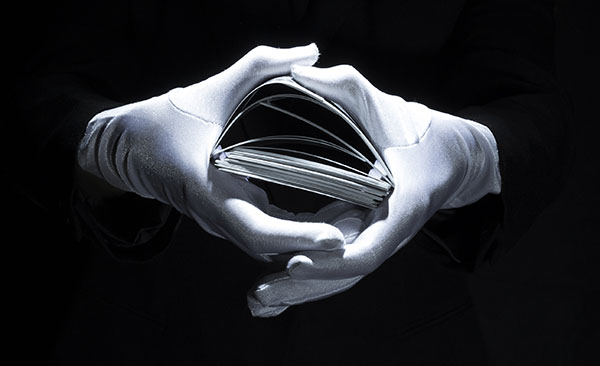Close-up Magician

Dive into the magical world of a close-up magician!
Welcome to the fascinating world of a close-up magician! Have you ever wondered how illusions are created up so close? This type of magic, also known as close-up magic, offers spectators a captivating and immersive experience. The close-up magician is an expert in the art of manipulating objects and making them disappear before your astonished eyes. Whether at a private event or a public show, these magicians blend into the crowd and dazzle their audience with their unusual sleight of hand. Their arsenal includes cards, coins, ropes, banknotes and many other everyday objects. Thanks to their manual dexterity and incredible sensitivity, they create illusions that defy logic and amaze audiences.
Whether you’re a fan of magic or just curious to discover something new and impressive, immerse yourself in the magical world of a close-up magician and prepare to be amazed by his incredible skill and ingenuity.
What is close-up magic?
Close-up magic is a form of magic that takes place at a short distance from the audience. Unlike traditional stage magic, where magicians use larger props and perform in front of a more distant audience, close-up magic focuses on visual effects performed just a few centimetres from the spectators’ eyes.
Close-up magicians mainly use everyday objects such as playing cards, coins, banknotes and rope to create their illusions. Their aim is to surprise, entertain and amaze the audience by creating effects that are impossible to explain rationally.
This type of magic offers a more intimate and interactive experience for the audience, as they are often invited to actively participate in the tricks. Spectators can watch the magician’s every move up close and try to understand how the illusions are created. It is this level of proximity that makes close-up magic so captivating and impressive.
The history of close-up magic
Close-up magic has a long history that goes back centuries. Although the exact techniques used by modern close-up magicians probably differ from those used by magicians of the past, the idea of creating close-up illusions has always fascinated people. One of the earliest mentions of close-up magic dates back to ancient Egypt, where magicians used manipulative techniques to entertain the pharaohs and their court. Over the years, this form of magic developed and evolved, finding its way into royal courts, cabarets and even the streets.
In the 19th century, close-up magic became increasingly popular with magicians such as Jean-Eugène Robert-Houdin, considered to be one of the fathers of modern magic. Robert-Houdin used elegant props and subtle movements to create powerful illusions at close range. His influence on close-up magic is still visible today.
The different styles of close-up magic
Close-up magic comes in many different forms and styles, each with its own distinctive characteristics. Here are some of the most popular styles of close-up magic:
1. Card magic
Card magic is one of the most emblematic styles of close-up magic. Magicians use packs of cards to perform amazing illusions, such as the disappearance and reappearance of selected cards, the manipulation of cards through obstacles and many more.
2. Coin magic
Coin magic focuses on manipulating coins to create visual and aural illusions. Magicians can make a coin disappear in their hand and reappear in an unexpected place, or make a coin pass through solid glass.
3. String magic
String magic involves manipulating strings to create amazing effects. Magicians can make a rope disappear and reappear in a perfect knot, or cut a rope in half and instantly put it back together again.
4. Magic using everyday objects
This style of close-up magic uses everyday objects such as banknotes, pens, rings or rubber bands to perform surprising illusions. Magicians can make a banknote disappear and find it inside a piece of fruit, or make a pen pass through a card without leaving a trace. The creativity of close-up magicians knows no bounds when it comes to using ordinary objects to create magical moments.
5. Digital magic
A new type of magic has emerged, blending the ancient art of illusion with modern technology. The fascinating art of the digital magician pushes the boundaries of the imagination by using electronics, augmented reality and interactive media to create unprecedented illusory experiences.
These styles of close-up magic are just a few examples. Each close-up magician develops his or her own style and techniques to create unique and impressive illusions.
The benefits of close-up magic
Close-up magic offers many advantages for both the magician and the audience. Here are some of the main advantages of this type of magic:
1. Interaction:
Unlike stage magic, where the audience is often simply a spectator, close-up magic allows direct interaction between the magician and the spectators. Spectators can actively participate in the tricks, touch the objects used by the magician and even be the main actors in certain illusions. This creates a more immersive and memorable experience.
2. Accessibility:
Close-up magic can be performed in many different contexts, whether it’s a private event, a wedding, a birthday party or even a corporate evening. It doesn’t require a special stage or sophisticated equipment, making it easily accessible to a wide audience.
3. Amazement:
One of the main aims of magic is to arouse wonder and amazement in the audience. Close-up magic, by taking place just a few centimetres from the spectators’ eyes, creates moments of intense amazement and makes the illusions even more incredible. It offers the audience a unique and memorable experience.
4. Flexibility:
Close-up magicians are often very versatile and can adapt to different situations and audiences. They can perform in confined spaces, circulate among guests at an event or even perform illusions on the fly in informal situations. This flexibility allows close-up magicians to adapt to many different types of event and create magical moments wherever they go.
How to become a close-up magician
If you’re interested in close-up magic and want to become a magician yourself, here are a few steps to get you started:
- 1. Learn the basics: Start by learning the basic techniques of close-up magic, such as card manipulation, coin techniques and rope knots. There are many books, videos and online resources that can help you learn these skills.
- 2. Practise regularly: Close-up magic takes practice and patience. Spend time every day practising and perfecting your techniques. The more you practise, the more comfortable and confident you’ll feel performing.
- 3. Study the masters: Study the work of the great local magicians for inspiration and to learn from their techniques. Watch videos of their performances, read their books and attend their shows if you get the chance. This will help you develop your own style and understand the fundamentals of close-up magic.
- 4. Practice in front of an audience: Once you feel comfortable enough with your skills, practice in front of an audience. This could be your family, friends or even strangers in an informal setting. Practising in front of an audience will help you gain confidence and fine-tune your performance based on the audience’s reactions.
- 5. Take part in competitions: Magic competitions are a great opportunity to showcase your skills and receive constructive feedback from expert judges. Look for local or national competitions in your area and sign up to take part. This will push you to constantly improve and push your limits as a close-up magician.
Becoming a close-up magician takes time, practice and determination, but it’s an exciting journey that can allow you to create magical moments for others.
The best close-up magicians in the world
The world of close-up magic is full of incredible talent that has captivated millions of spectators around the world. Here are some of the best close-up magicians to look out for:
- 1. David Blaine: David Blaine is undoubtedly one of the most famous and influential close-up magicians of our time. He is known for his street magic performances and daring challenges, such as staying buried alive for several days. His ability to create astonishing illusions just a few centimetres from the public eye has made him famous throughout the world.
- 2. Derren Brown: Derren Brown is a British magician renowned for his ability to combine close-up magic with psychology and mental influence. His shows are full of astonishing moments when he seems to read the spectators’ minds and predict their choices. He has revolutionised the world of close-up magic by adding a fascinating psychological dimension.
- 3. Shin Lim: Shin Lim is an American magician of Singaporean origin who has twice won the world championship in close-up magic. He is known for his incredible dexterity and visually stunning card routines. His unique style and captivating stage presence make him one of the most popular close-up magicians of his generation.
- 4. Dynamo: Dynamo, whose real name is Steven Frayne, is a British magician who made his name with his TV series “Dynamo: Magician Impossible”. His close-up magic performances in public and urban settings have amazed audiences around the world. He is known for his ability to make objects fly, walk on water and perform impossible illusions.
These close-up magicians are just a few of the many examples that have pushed the boundaries of close-up magic and inspired generations of magicians around the world.
Events where close-up magic is popular
Close-up magic is becoming increasingly popular at a variety of events and special occasions. Here are some of the events where close-up magic is particularly popular:
1. Weddings:
Weddings are the perfect opportunity to add a touch of magic and wonder. Local magicians can entertain guests during cocktails, breaks between courses or while they wait. Their presence adds a dose of surprise and entertainment to the event, creating unforgettable memories for the bride and groom and their guests.
2. Birthday parties:
Birthday parties are another occasion where close-up magic is very popular. Local magicians can entertain both children and adults with their amazing illusions. Whether it’s a child’s birthday or an adult’s birthday, close-up magic adds a fun and captivating dimension to the party.
3. Corporate events:
Corporate events, such as gala evenings, product launches and team meetings, can benefit from the addition of close-up magicians to entertain attendees. Close-up magic breaks the ice, creates moments of surprise and enhances interaction between participants.
4. Festivals and public events:
Festivals and public events are ideal opportunities for community magicians to perform and interact with a wide audience. Whether on the street, in parks or on outdoor stages, close-up magic can captivate and entertain spectators of all ages.
Close-up magic can be adapted to many types of events and special occasions. Whether it’s a formal or informal event, the presence of a close-up magician can add a touch of magic and surprise to any occasion.
Conclusion: The impact of close-up magic on the public
Close-up magic has a powerful impact on audiences, creating moments of wonder, surprise and connection. It transcends language and cultural barriers, captivating audiences of all ages and backgrounds.
When we witness an illusion up close, our minds are transported into a state of fascination and amazement. We are encouraged to question our perception of reality and to marvel at the infinite possibilities of the human mind.
Close-up magic also creates moments of connection and interaction between the magician and the audience. Spectators are invited to take an active part in the tricks, to touch the objects used by the magician and to become actors in the illusion. This creates a unique bond between the magician and the audience, making the experience even more memorable.
In short, close-up magic is much more than just entertainment. It’s a way of creating magical moments, stimulating our imagination and connecting us with others. So immerse yourself in the magical world of close-up magicians and prepare to be dazzled by their talent and ingenuity!
